Category: Team
Dr. Santiago Demierre has been an integral part of the Palm Beach Equine Clinic team of veterinarians for the past 10 years. Dr. Demierre primarily focuses on equine performance medicine and is passionate about the prevention and treatment of lameness in sport horses. Keep reading to learn more about Dr. Demierre’s backgroundand his role at Palm Beach Equine Clinic.
Dr. Demierre was raised in San Antonio de Areco, a small town in the countryside outside Buenos Aires, Argentina. He grew up immersed in the equine industry as his father was a racehorse breeder and trainer. Dr. Demierre completed his veterinary medicine degree from the Universidad de Buenos Aires in 2012.
He began his career at Palm Beach Equine Clinic as an intern and then went on to become an ambulatory veterinarian before focusing on sport horse medicine. Dr. Demierre currently cares for some of the country’s top polo, jumper, and dressage horses.
“We have worked with Dr. Demierre several times now, and we love his determination and patience when it comes to the welfare of our horses,” said U.S. show jumping athlete Ali Boone. “He is the first one there in any urgent care we have needed, and he not only puts the animals’ needs above all else, but he also takes the time to explain and talk through any diagnosis and situation that needs special attention.”
At Palm Beach Equine Clinic, Dr. Demierre enjoys being surrounded by a diverse group of exceptional veterinarians who are always available to advise on a case. Dr. Jorge Gomez, Dr. Robert Brusie, and Dr. Scott Swerdlin have all played influential roles in Dr. Demierre’s career by providing guidance on managing cases and clients.
In his free time, Dr. Demierre stays busy riding polo ponies, fishing, hunting, hiking, and enjoying time outdoors.

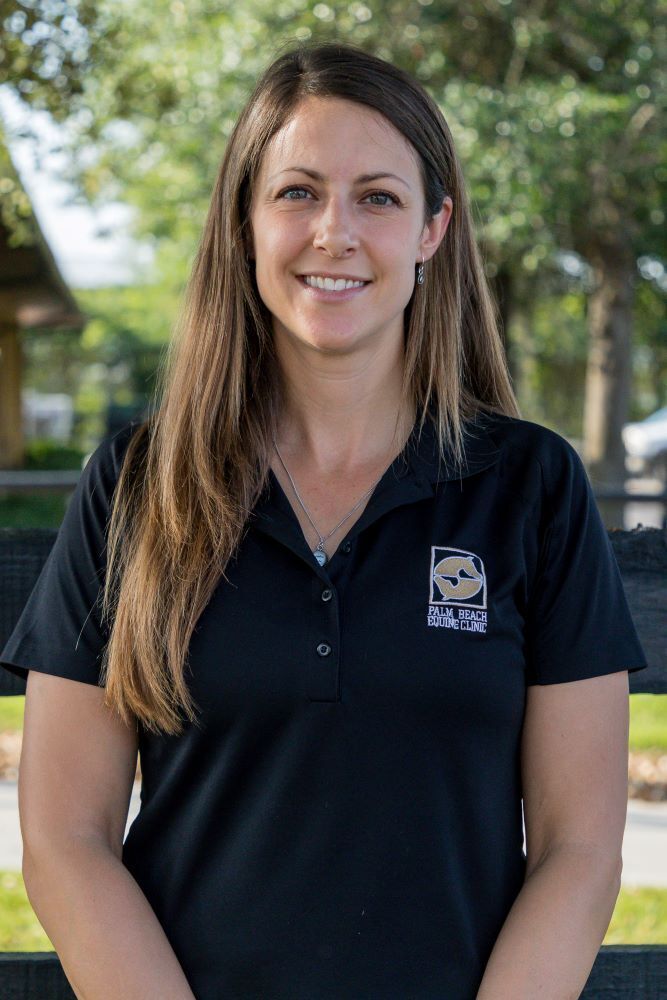
Where did you grow up and what is your background with horses?
I’m Canadian, and I grew up in Winnipeg, Manitoba. Even though I lived in the city I was obsessed with horses from a young age and begged my mom for riding lessons. When I was 17 years old I started grooming horses for the polo circuit in Winnipeg and the obsession continued from there.
When and why did you decide to become a veterinarian?
I wasn’t sure what to do after high school, and becoming a veterinarian had always been a possibility but I couldn’t decide. I took a year off and went backpacking in Australia. During that time, I worked on a mango farm one and of the dogs got into a scrap with another dog. He was cut up so I took the first aid kit and doctored his wounds. That’s when I decided becoming a veterinarian was the way to go. I called my mom the same night and told her, and she was more than a little relieved.
Who has been the biggest influence in your life or career? What did they teach you?
The biggest influence in my life is my mom. She has taught me too many things to count. At the top of that list is to work hard in whatever you do. She taught me to always put forth your best effort, always leave a place better than how you found it, and always be kind and respectful to whomever you meet.
The biggest influence in my career is Dr. Jorge Gomez. He also believes in the importance of hard work, and he has helped me learn how to run a business. He has instilled in me the value of doing a good, thorough job and maintaining a high standard of practice.
What do you enjoy most about working with performance horses?
What I enjoy most about working on performance horses is a simple answer: watching a horse you care for succeed and perform well. The horses we work on are incredible athletes, and it’s a privilege to be a part of the team that cares for them.
What do you enjoy most about working at Palm Beach Equine Clinic?
What I enjoy the most about working at Palm Beach Equine Clinic is having so many specialists and vets with experience available to help with complicated cases. There is always someone to ask or give advice, and surrounding yourself with people like that ensures you are always providing the best standard of care possible.
What is something interesting that people may not know about you?
Scuba diving is my absolute favorite non-equine activity. In a different life if I never was a horse-crazy person I would have been a marine biologist and found a job that included scuba diving.
Palm Beach Equine Clinic served as Official Treating Veterinarian during the Longines Global Champions Tour (LGCT) of Miami Beach in Miami, FL, from Sunday, April 9 through Sunday, April 16, 2023. Dr. Christopher Elliott was on-site daily during this international competition. Keep reading to learn about Dr. Elliott’s week while at this one-of-a-kind venue.

Photo courtesy of Dr. Christopher Elliott
Arrival of International Horses – Sunday, April 9, 2023
The first day started at the airport with the arrival of the international horses. During this process, Palm Beach Equine Clinic veterinarians worked alongside the government veterinarians from the United States Department of Agriculture (USDA) to make sure all the horses arriving were happy and healthy. While the horses were still on the airport tarmac, a team of government and local veterinarians performed the first two steps of the arrival process. First, we checked and cross-referenced microchips to confirm each horse’s identity. Then we took blood samples from each horse.
All horses entering the U.S. had to be in quarantine for 48 hours under USDA government control. There are very strict veterinary protocols to ensure no diseases are inadvertently introduced into the country. Upon arrival in quarantine, horses were inspected by the USDA veterinarians for any evidence of illness or injury. All the horses in quarantine had their temperature taken and were inspected for any ectoparasites.
After being strictly monitored, including twice-daily veterinary inspections and temperature checks, the international horses were released from strict quarantine into the controlled competition environment. The international horses were housed in separate stables from domestic American horses. They were also kept separate in the training arena. Throughout the duration of the competition, all international horses were strictly monitored by both government veterinarians and the official veterinarians of the competition. All of these procedures are designed to prevent the inadvertent introduction of foreign or infectious diseases and protect the U.S. horse population. Fortunately, all of the international horses that arrived in Miami had no health concerns.
Arrival Examination Day for National Horses, Horse Inspection, and Arena Familiarization – Thursday, April 13, 2023
I began Thursday at the competition venue with the arrival examination for all FEI horses who were already in the United States.
We inspected each national horse for any obvious signs of illness or injury, and then we scanned their microchip. Our microchip readers are linked via Bluetooth to our phones so when we scan a microchip, we can see all of the horse’s FEI details within the veterinary side of the FEI HorseApp. The app gives us all the information we need to know about the horse and whether all of the documentation was done correctly. Before the horses arrived at the competition venue, the owners and riders were required to complete documentation on the FEI HorseApp including the self-declaration of health stating that their horses were healthy prior to arriving at the venue. They also had to take their horses’ temperatures in the morning and evening for three days prior to arrival at the FEI venue and record it in the app.

Photo courtesy of Dr. Christopher Elliott
After we checked that information, we looked at the horse’s passport to make sure it was up to date with all of its vaccinations. We checked that the last Equine Influenza vaccination was within six months and 21 days of arrival at the horse show. We also asked the rider or groom to take the horse’s temperature right then and there to make sure it is good.
Once the horses were all checked in, the horse inspection for national and international horses got underway. I supervised all of the national and international horses going through horse inspection. As the Official Treating Veterinarian, I worked with the veterinary delegate who traveled in from Italy since LGCT has a very international team. During the horse inspection, my role was to make sure everything ran smoothly. I was also there to examine any horses that might not have been successful through the jog but fortunately they all passed the jog. After the horse inspection, it was time for arena familiarization and schooling where I stood ringside to make sure all horses stayed injury free.
Competition Days – Friday, April 14 through Sunday, April 16, 2023
The competition days started really early. Thankfully at this event it’s not too bad because you get to see the sunrise over the ocean. The warm-up and schooling arena opened at 5:30 a.m., so I was on-call by the schooling arena then to make sure all horses were happy and healthy.

Photo courtesy of Dr. Christopher Elliott
Once the competition began, I was right there at the in-gate with the emergency veterinary kit bag just in case I needed to attend to any horses in the ring. Fortunately we only had to look at a couple of very minor things throughout the competition.
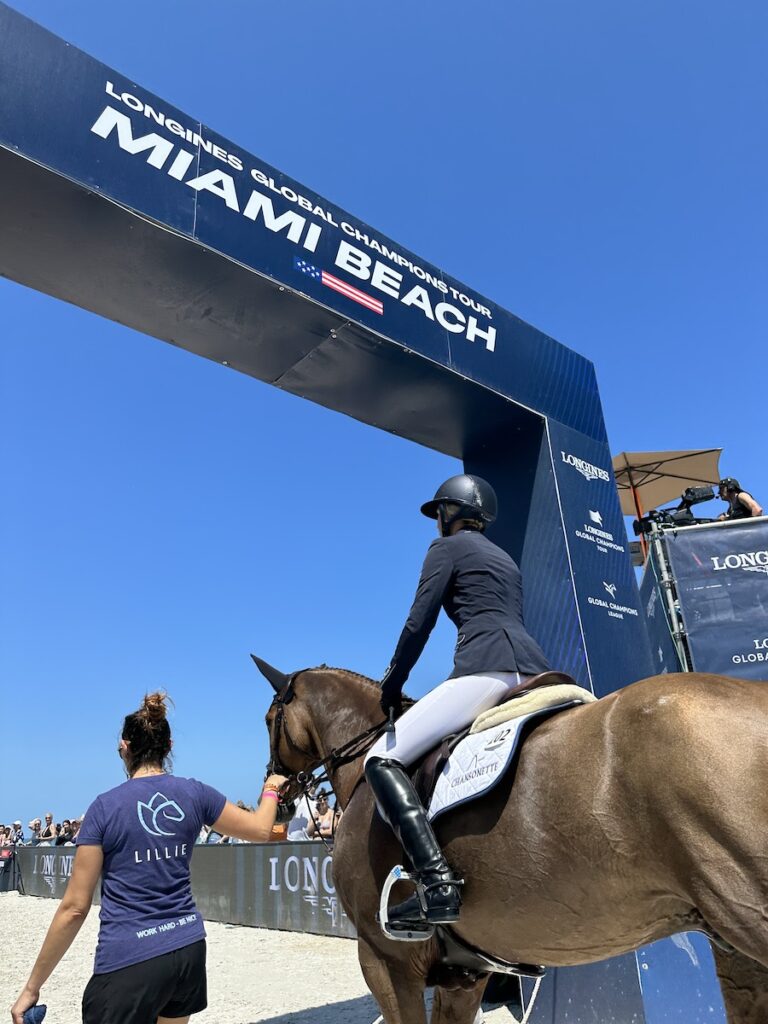
Photo courtesy of Dr. Christopher Elliott
In the afternoons my role changed to supporting the horses’ recovery from the competition day. Dr. Sarah Allendorf from Palm Beach Equine Clinic came down from Wellington each afternoon to help. Between the two of us, we examined horses after they competed and advised riders and grooms on how best to look after them in preparation for the next day. We administered some supportive therapies within the rules of the FEI. On Saturday it was very hot and humid, so we administered some fluids to help the horses recover and ensure they were fit and healthy for the following day.
On Sunday afternoon while the final CSI2* competition was taking place, Dr. Allendorf and I prepared the international horses for their next journey. We made sure the horses were healthy and ready to travel. We escorted them to the airport where they went on to the next LGCT event – Mexico City!
On Sunday afternoon while the final CSI2* competition was taking place, Dr. Allendorf and I prepared the international horses for their next journey. We made sure the horses were healthy and ready to travel. We escorted them to the airport where they went on to the next LGCT event – Mexico City!
Which veterinarian do you work with, and how long have you been at Palm Beach Equine Clinic?
I work with Dr. Bryan Dubynsky who specializes in sport horse medicine. I started working at Palm Beach Equine Clinic at the beginning of 2022. I began as a veterinary technician in the Hospital Barn and then transitioned to working with Dr. Dubynsky.
What does a typical day look like for you at Palm Beach Equine Clinic?
A typical day starts with restocking the vet truck. I always make sure we have all the drugs and supplies we will need for the day. Once the truck is stocked, we spend the day traveling to different barns in the area treating and evaluating horses.

Photo courtesy Laura Romero
What made you decide to become a veterinary technician?
I grew up in Okeechobee, FL, and I enrolled in my high school’s veterinarian program. I was also part of the agricultural program at my school. I found both of those courses very interesting, and they inspired me to become a veterinary technician.
What is your background with horses?
I grew up riding western as a kid and always loved being around horses.
What do you enjoy doing in your free time?
I love to travel and spend time with my friends.
Dr. Natalia Novoa has been part of the Palm Beach Equine Clinic team since 2011. Dr. Novoa focuses primarily on sport horse medicine, lameness, pre-purchase exams, chiropractic adjustments, acupuncture and preventative medicine.
When and why did you decide that you wanted to become a veterinarian?
I decided to become a veterinarian when I was in high school. I enjoyed working with animals at my family’s farm. I spent time with the farm’s vet, and I learned how to do artificial insemination before I even finished high school. I liked the problem-solving aspect of it. I found it fascinating to have the ability to identify and understand what the problem was and then help relieve the suffering of animals after injuries or illnesses. It was an indescribable sensation. Nothing beats helping an animal when they are sick or in pain. There is nothing more rewarding than knowing you are making a difference in a horse’s life. It is a very satisfying feeling.

Photo courtesy of Dr. Natalia Novoa
What aspects of equine medicine interest you most, and what types of cases do you find most rewarding?
I am most interested in sports medicine and lameness (conventional medicine) as well as alternative medicine (chiropractic adjustments and acupuncture). The most rewarding cases for me are the challenging ones where I have to “solve the puzzle.” I like when I have to rely on my detailed observation including a thorough exam and accurate history, then put together all the data and information I gathered from the diagnostic tools, choose the appropriate treatment, and then reach a successful outcome.
What do you enjoy most about working with performance horses?
I enjoy treating them as top athletes through the combined use of our practical skills, the new technology, and evolving therapies. At Palm Beach Equine Clinic, we are very fortunate to work on a variety of horses of all disciplines, including horses that are the best athletes in the world in dressage, show jumping, polo, etc. We use the most advanced equipment to provide the best service. Also, at Palm Beach Equine Clinic we have an amazing team of veterinarians with different specialties, knowledge, and skills to help these performance horses execute and perform at their best.

Photo courtesy of PBEC
What has been one of your favorite moments while working for Palm Beach Equine Clinic?
One of my favorite moments was when my daughter Lola told me she wanted to be a veterinarian after watching the process of resolving a challenging lameness case in a grand prix level show jumping mare. Lola was able to observe the positive outcome and cheered for the mare when she won a big jumper class.
What is something interesting that people may not know about you?
I am a fearless squash player, and I also enjoy playing tennis and ping pong. I love traveling with my family and showing my daughter Lola the world.
What is something interesting that people may not know about you?
I am a fearless squash player, and I also enjoy playing tennis and ping pong. I love traveling with my family and showing my daughter Lola the world.
Do you ever wonder what all those letters at the end of a veterinarian’s name actually mean? It is kind of like a secret language where they signify a variety of different veterinary qualifications. Palm Beach Equine Clinic explains how to crack the code of letters.
DVM
Doctorate of Veterinary Medicine: This qualification is given to graduates of veterinary colleges. Although this was once only for graduates of American veterinary colleges, the abbreviation is now given to graduates from several other universities around the world. The vast majority of the veterinarians at Palm Beach Equine Clinic are DVMs that earned their degrees at U.S. institutions.
DACVS
Diplomate of the American College of Veterinary Surgeons: Holders of this qualification are board-certified specialists in Surgery. Board-certified means that the veterinarian has a mastery of advanced knowledge and skills after completing required testing. At Palm Beach Equine Clinic, Dr. Robert Bruise, Dr. Jorge Gomez, Dr. Weston Davis, Dr. Liz Barrett, and Dr. Karen Beste are all specialist surgeons.

Photo by Jump Media
DACVIM
Diplomate of the American College of Veterinary Internal Medicine: This qualification means that the veterinarian is board-certified in Internal Medicine. Dr. Peter Heidmann and Dr. Fernando Marqués of Palm Beach Equine Clinic are both board-certified specialists in Internal Medicine.
DACVR
Diplomate of the American College of Veterinary Radiology: This qualification indicates the holder is a board-certified specialist in Radiology. Palm Beach Equine Clinic’s Dr. Sarah Puchalski is a DACVR.
DACVSMR
Diplomate of the American College of Veterinary Sports Medicine and Rehabilitation: A relatively new specialty, this qualification indicates the veterinarian is a board-certified specialist in Sports Medicine and Rehabilitation. Both Dr. Christopher Elliott and Dr. Fernando Marqués of Palm Beach Equine Clinic have this qualification.
BVETMED
Bachelor of Veterinary Medicine: This distinction is given to veterinary graduates of the Royal Veterinary College (RVC) in London, which is the first and oldest English-speaking veterinary college in the world. Dr. Richard Wheeler and Dr. Charlie McColough of Palm Beach Equine Clinic are both graduates of the famous RVC.
BVM&S
Bachelor of Veterinary Medicine & Surgery: These letters indicate a graduate of The Royal (Dick) School of Veterinary Studies in Edinburgh, Scotland, which is Scotland’s oldest veterinary school. Palm Beach Equine Clinic’s Dr. Sarah Allendorf is a Dick Veterinary graduate.
BVMS
Bachelor of Veterinary Medicine & Surgery: This particular abbreviation is given to graduates of several British veterinary schools. At Palm Beach Equine Clinic, Dr. Janet Greenfield Davis and Dr. Tyler Davis both have this qualification as graduates of the Glasgow University School of Veterinary Medicine.

Photo by Jump Media

Photo by Jump Media
BVSc
Bachelor of Veterinary Science: These letters were typically associated with veterinary graduates from Commonwealth countries such as Australia and New Zealand. The qualification is now granted by numerous vet schools around the world. Within Palm Beach Equine Clinic, Dr. Christopher Elliott has this qualification from the University of Queensland School of Veterinary Science in Australia.
MVB
Bachelor of Veterinary Medicine: This renowned abbreviation indicates graduates of the University College Dublin School of Veterinary Medicine, which is Ireland’s only veterinary school. Dr. Laura Hutton of Palm Beach Equine Clinic is a University College Dublin School graduate.
MVZ
Medico Veterinario Zootecnista: This qualification is given by several Spanish-speaking veterinary schools. Palm Beach Equine Clinic’s Dr. Jorge Gomez has this qualification as a graduate of the University of Caldas in Colombia.
MRCVS
Member of the Royal College of Veterinary Surgeons: These celebrated letters indicate the holder as satisfying the stringent regulatory requirements to practice as a Veterinary Surgeon in the United Kingdom. At Palm Beach Equine Clinic, Dr. Richard Wheeler, Dr. Scott Swerdlin, Dr. Stephen O’Grady, Dr. Janet Greenfield Davis, Dr. Tyler Davis, Dr. Charlie McColough, Dr. Sarah Allendorf, and Dr. Christopher Elliott are all MRCVS.
MANZCVS
Member of the Australian and New Zealand College of Veterinary Scientists: These letters indicate the veterinarian has studied at the Australian and New Zealand College of Veterinary Scientists and is an advanced practitioner in a particular area of veterinary science. Dr. Christopher Elliott of Palm Beach Equine Clinic is a MANZCVS in Equine Sports Medicine and Rehabilitation.

Photo courtesy of Dr. Christopher Elliott
CERPM
Certified in Equine Rehabilitation & Performance Medicine: This is a post-veterinary school qualification focusing on the early diagnosis of performance deficits, how to correct them, and rehabilitation after injury. Palm Beach Equine Clinic’s Dr. Janet Greenfield Davis holds this qualification.
CVA
Certified in Veterinary Acupuncture: Veterinarians with this post-veterinary school qualification have studied the fundamentals of equine acupuncture including points and techniques. This is a postgraduate qualification also held by Dr. Janet Greenfield Davis.
CVMMP
Certified Veterinary Medical Manipulation Practitioner: This is a post-veterinary school qualification where veterinarians are educated in how to perform medical manipulation to treat musculoskeletal problems. Dr. Ryan Lukens of Palm Beach Equine Clinic has this qualification.
Dr. Karen Beste joined the Palm Beach Equine Clinic team in January 2023. Dr. Beste is a board-certified large animal surgeon. Keep reading to learn more about Dr. Beste and her background as a veterinarian.
Where did you grow up and what is your background with horses?
I grew up in a small town in north Texas called Double Oak. My father loved horses. His parents had a small property with several horses and a Shetland pony that I learned to ride on. We were involved with the Lewisville Saddle Club and went to “playdays” together throughout my childhood where I learned how to barrel race and compete in speed events. During this time I started to train my own horse named Buck. I joined the Marcus Rodeo Team and competed in high school rodeo for four years with Buck who took me to the finals for pole bending my senior year. In college I switched gears and joined the Texas A&M University polo club my freshman year. I quickly fell in love with the game, and through a lot of hard work I made the polo team my sophomore year. During my senior year I went on to be the team captain.
When and why did you decide you wanted to become a veterinarian?
I decided I wanted to be a veterinarian at a very young age. When one of our horses became injured and ultimately had to be euthanized despite surgical intervention efforts I knew I wanted to be able to help horses as a career. In third grade I wrote a book describing how I wanted to go to Texas A&M University in order to become a veterinarian, and I followed my dream.
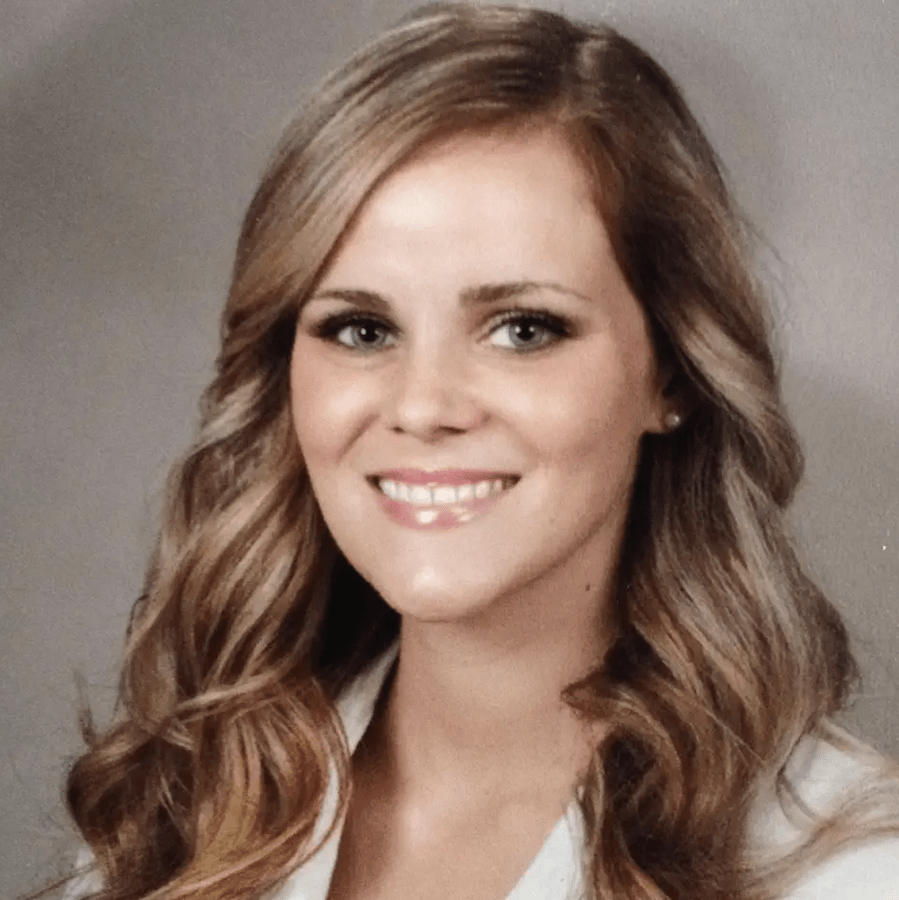
Photo courtesy of Dr. Karen Beste
What is some advice you would give someone who wants to become a veterinarian?
I would recommend they spend as much time as they can with a veterinarian. It is important to understand the commitment that is required and how rewarding it can be working on animals that people not only compete on but truly love as members of their family.
What aspects of equine medicine interest you most, and what types of cases do you find most rewarding?
As a surgeon, I am obviously interested in being in the operating room and helping horses in emergency situations or with routine surgery. I find the most joy in watching a horse I have been involved with have a good outcome in the show ring following surgical intervention.
What is something interesting people may not know about you?
The most exciting animal I have done surgery on was a baby bongo!
Sarah Panico has been a part of the Palm Beach Equine Clinic team for the past seven years. Panico is one of the Hospital Technicians and is an integral member of our Hospital Management team.
Panico grew up riding horses, and by age 14 she was the assistant manager of a private stable in Coconut Creek, FL. She later began teaching lessons, running summer camps, training horses, and more. Panico started competing and traveling on the show jumping circuit in New York, Kentucky, and Canada. In 2015, at the age of 19 she decided she was ready for a change and applied for a position at Palm Beach Equine Clinic. The rest was history, and Panico found her true passion as a Hospital Technician.
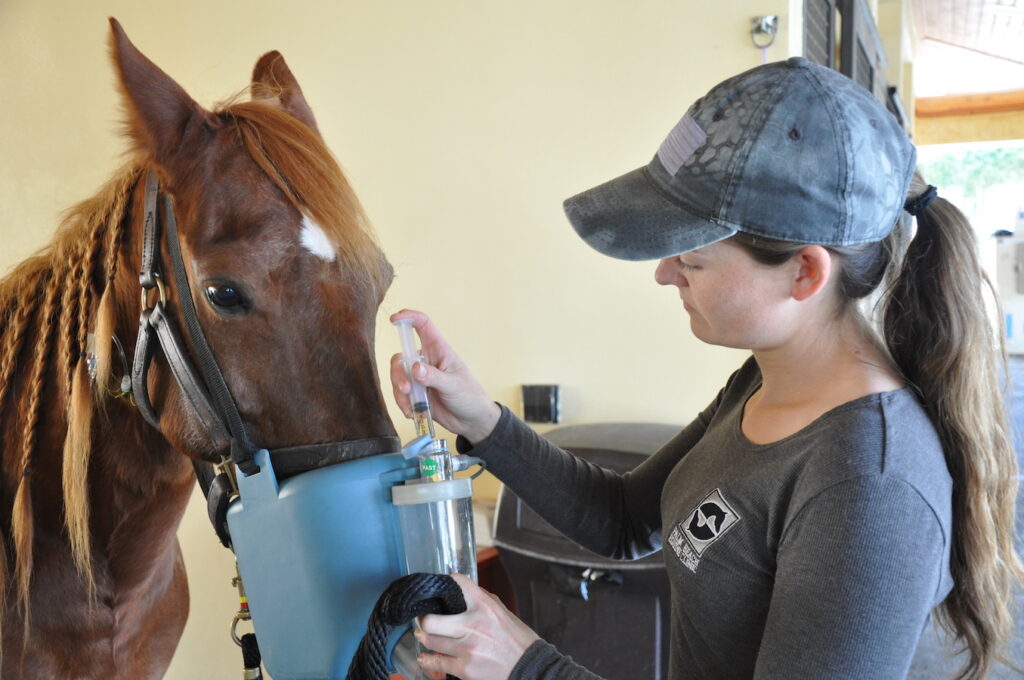
Photo courtesy of Sarah Panico
“I absolutely love spending time with my patients and pouring every ounce of my abilities into the care of these amazing equine athletes,” commented Panico. “It’s such a great feeling being able to help them. There’s no greater feeling than watching a patient you’ve spent so much time caring for and rooting for improve and get to go home. On the other hand, there are days when sad moments occur too. Having the opportunity to be the person who is with these horses, providing them with love and compassion in their final moments, is certainly difficult but honorable at the same time.”
A typical day for Panico at Palm Beach Equine Clinic starts with doing early morning treatments, running blood work, placing catheters, performing physical exams, and admitting patients for elective surgeries or procedures. If there is a patient that is in a more critical condition, the majority of her time is dedicated to that patient. Being part of the Hospital Management team means that she handles the more critical cases and assigns the other patients accordingly.

Photo courtesy of Sarah Panico
“There are days we have multiple emergencies come to the clinic at all different times, and sometimes there are multiple emergencies at the same time,” explained Panico. “Some end up going into emergency surgery right away. Time management, communication, and delegation are vital in this profession. You never know what is in store for the day, and honestly that’s probably my favorite part. I enjoy the unknown as to what my day will be like, the fast-paced environment, caring for critical patients, aiding the doctors, and the unique cases that come in.”
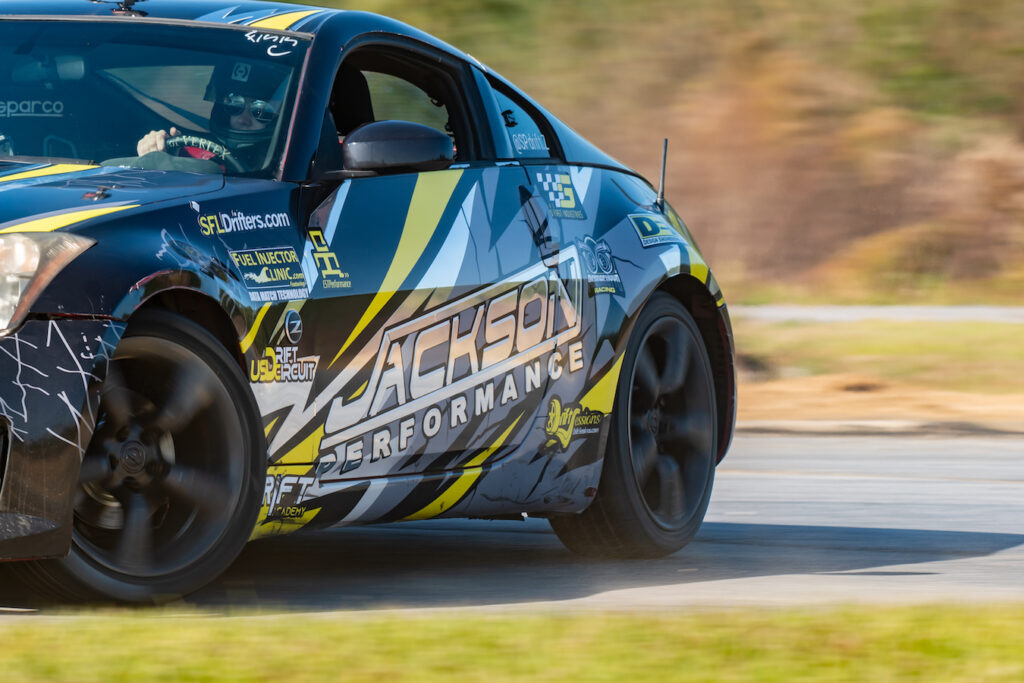
Photo courtesy of Sarah Panico
Outside of Palm Beach Equine Clinic, Panico can be seen driving her drift car. Although it is something she does for fun, she is looking forward to being able to compete next year. She also enjoys traveling, boating, fishing, going to the gun range, and spending time with her German Shepherd, Layla.
The team at Palm Beach Equine Clinic is excited to welcome Dr. Christopher Elliott. Dr. Elliott was born and raised in Brisbane, Australia, and graduated from the University of Queensland’s School of Veterinary Science in 2007 with First-class Honors. Since then, he has become board-certified in Sports Medicine and Rehabilitation. Dr. Elliott has experience working at Fédération Équestre Internationale (FEI) equestrian events in more than 20 countries. As well as being a dedicated FEI Veterinarian, Dr. Elliott has been a Private Athlete Veterinarian, Team Veterinarian, Permitted Treating Veterinarian, and Official Veterinarian. Dr. Elliott is the Veterinary Services Manager for FEI Competition at Wellington International for the 2023 Winter Equestrian Festival. Keep reading to learn more about Dr. Elliott and his role as a veterinarian at Palm Beach Equine Clinic.

Photo courtesy of Dr. Christopher Elliott
When and why did you decide you wanted to become a veterinarian?
Like most young boys I knew, I had illusions of grandeur that I was going to be playing cricket or rugby for Australia. As I got older, I decided I needed to knuckle down on my studies and veterinary medicine made sense. I decided this around the age of 15 and, since then there was nothing else I could possibly imagine I ever wanted to do. My background in horses from my father’s side and my love of animals from my mother’s side led me to veterinary medicine as the perfect career and lifestyle choice for me.
What advice would you give someone who wants to become a veterinarian?
Young people considering a career in veterinary medicine should spend as much time as possible working in practices in order to fully understand what makes it a challenging career choice. Aspiring veterinarians should take the time to truly understand what the profession is really about. I love being a veterinarian and it is all I could possibly imagine ever doing, but some people have a job that pays for their lifestyle and other people have a job that is their lifestyle. Young people who would like to become a veterinarian should be positive that it is the career they want and enjoy before committing to it.
What aspects of equine medicine interest you most, and what types of cases do you find most rewarding?
My chosen specialties are Sports Medicine and Rehabilitation. Ever since I became a veterinarian, the unique challenges of keeping equine athletes fit, sound, and competing at the highest level have always appealed to me. I enjoy performance management, investigating lameness, and helping my clients achieve their equine athletic goals. Regardless of the competition level, each combination of horse and rider has specific aspirations, and it gives me great satisfaction to help achieve those goals. Whether it be in the pony ring, at the grand prix level, or Olympic level, they all pose their unique challenges and are equally enjoyable.
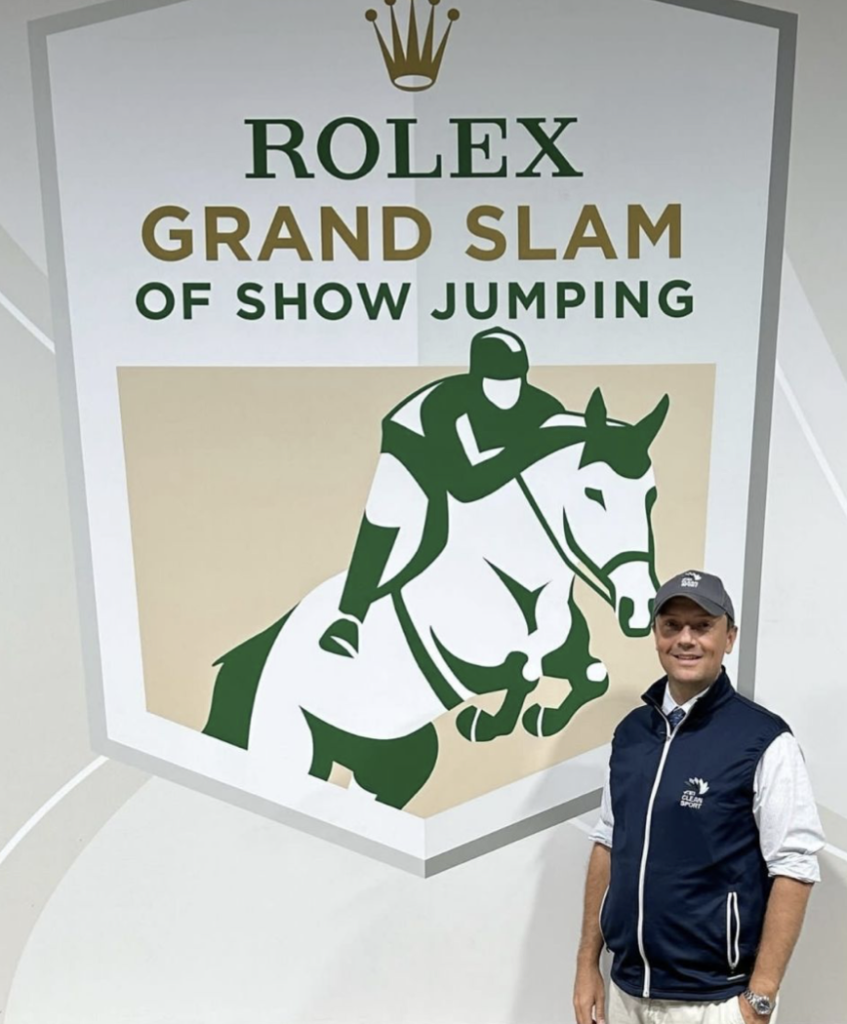
Photo courtesy of Dr. Christopher Elliott
What is your role as the new Veterinary Services Manager for FEI Competition at Wellington International?
My job as the Veterinary Services Manager is to provide veterinarian services during each week of FEI competition. Tasks range from coordinating our Palm Beach Equine Clinic treating veterinarians on the showgrounds to assisting during the arrival exams and horse inspections. I am also the Attending Veterinarian ringside for each night class and FEI class. I have been working within the FEI all over the world for close to 15 years, and I look forward to working at this prestigious venue this year.
What are some of your other hobbies or interests?
I love traveling with my wife, Kjersten Lance, and going on fun adventures around the world. I enjoy all things sports related as well. I love watching team sports, especially live at the stadium. Coming from Australia, I played cricket and rugby and still follow them closely. A little-known fun fact about me is that I collect stamps.
6:30 a.m. – 7:30 a.m.: Family Time/Morning Ritual
I like to start my morning with my two boys who are four and six years old. We get up and play a little before breakfast. We then all load into the car to head to school.
8:00 a.m. – 9:15 a.m.: Hospital Rounds
When I arrive at Palm Beach Equine Clinic, I convene with the hospital staff to discuss the hospitalized patients. There are about 15 horses currently hospitalized with us, though some of them are only here for MRI and bone scans or other outpatient procedures. During rounds, the hospital’s patient-care team of veterinarians and technicians make a plan for each patient and debate the best treatment strategies. This is an opportunity to make sure everyone is on the same page with the specific rationale for each treatment plan, and also an opportunity to quiz some of our younger veterinarians on the relevant science.
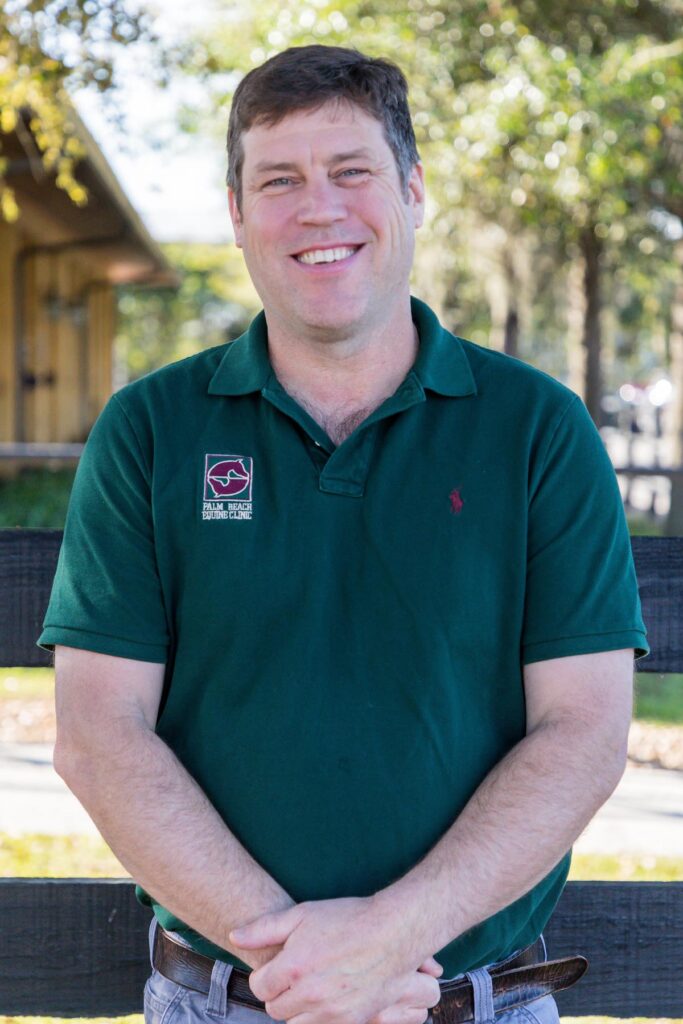
Photo by Jump Media
Today, I got into a good conversation with another senior clinician regarding the ideal choice of blood thinners to limit the risk of clotting in a sick patient. Although we did not totally agree, our diverging opinions provided some perspective to the young veterinarians during rounds. Honestly, even without complete consensus on any given topic, this kind of dialogue challenges us to remain abreast of the medical literature, helps us provide articulate and succinct presentations, and ultimately, promotes optimum patient care.
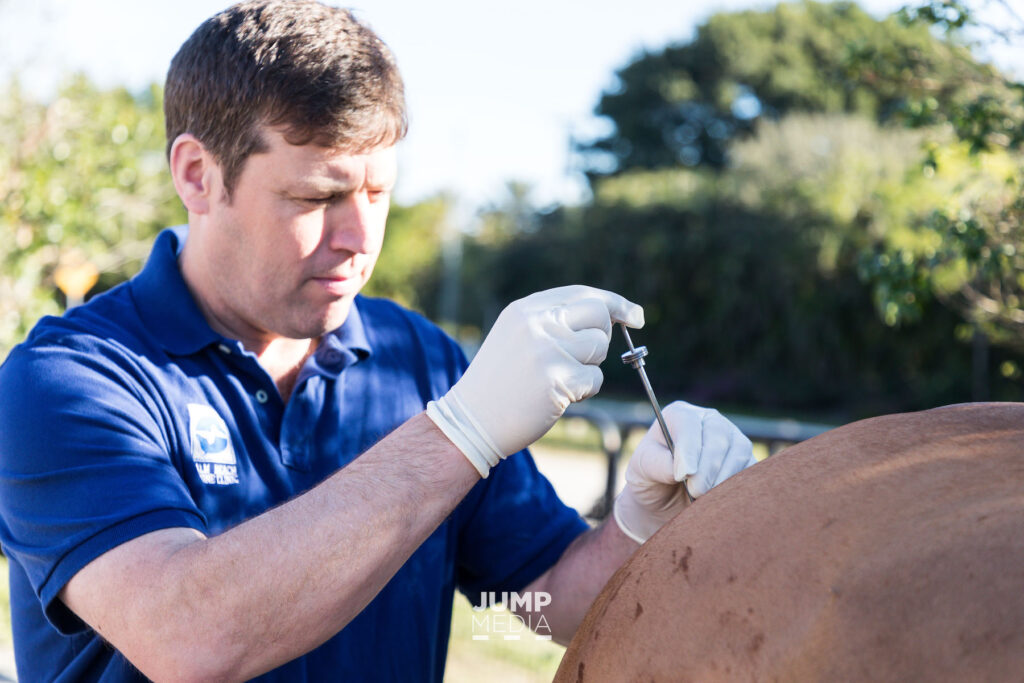
Photo by Jump Media
We also discussed modifying the treatment strategies for a six-year-old stallion who had colic surgery about 18 hours earlier. He was experiencing the all-too-common problem of “post-operative ileus” where the small intestine was not returning to normal motility as quickly as we would like. We increased the regimen of prokinetic drugs, which are IV medications that can help increase the contractions of that sluggish small intestine. We also discussed the possibility of increasing his hand-walking, which can improve his motility.
As we made our way through the barn, we talked about rechecking the current insulin levels of a 15-year-old Hanovarian mare who has been fighting founder for more than a week. If the insulin remains high, we may need to modify her treatment regime, including increasing her dose of metformin, a medication that can help modify the concentration of insulin in her bloodstream. Thankfully, it came back as normal when we checked it with the handy patient-side test called Wellness Ready.
Other notable cases included a mare who is hospitalized with us on foal-watch since her pregnancy is nearly full-term, a polo pony with a corneal ulcer (eye trauma), and an almost totally better horse that had presented to the hospital with a fever of unknown origin. After the fever had abated on its own within hours of hospitalization, he was set to remain boarded until his PCR tests confirm that he wasn’t shedding any infectious diseases and he could safely return to his home barn.
9:15 a.m. – 10:15 a.m.: Updating Clients
After hospital rounds, I spend a little bit of time returning calls and updating clients and owners on their hospitalized patients. I also document patient updates and client conversations in the medical record for each horse.
10:30 a.m. – 11:30 a.m.: Farm Call ¬– Follow-Up Gastroscopy
I arrive at a local farm along with one of our young veterinarians to do a recheck gastric scope to see how well a nine-year-old gelding has responded to 27 days of treatment for gastric ulcers. Our exam a month ago showed moderate gastric ulcers (Grade 2 out of 4 in severity) in the upper stomach (the “margo plicatus,” where the squamous stomach lining meets the portion that produces acid). There was also thickening around the pylorus, the outflow tract (“exit door”) at the bottom of the stomach. It’s good to see that the horse is acting much better, gained some weight, and has a healthier hair coat since we started treatment with Gastrogard omeprazole last month. We need to see how he has responded to a combination of medications, and hopefully, discontinue the anti-ulcer medications if possible. After a round of light sedation, we pass the endoscope into the stomach. The Grade 2/4 gastric ulcers are totally resolved, which is great news. The pyloric outflow tract is only a little bit better. Although it requires treatment twice a day, we recommend the addition of misoprostol, which is a medication that is often considered more likely to help resolve problems at the pylorus. We also discuss a plan to make sure that the horse has continuous access to grass hay and/or fresh grass in turnout. This can help prevent ulceration and, in some cases, promote healing without the necessity of additional medication. We write the prescriptions and make a plan to repeat the stomach scoping in another three to four weeks.
11:45 a.m. – 1:15 a.m.: Farm Call – Respiratory Evaluation
We continue to a second local farm to follow up on a case of suspected respiratory problems in a nine-year-old chestnut jumper mare. Earlier in the week, the mare’s regular veterinarian, who works with us at Palm Beach Equine Clinic, had been asked to evaluate her for shortness of breath and occasional coughing during and after work. The mare had been performing well, but had been a bit sluggish for the past three months. Recently, her symptoms had become much more obvious, especially after the mare finished training or competition. This raised the trainer’s concerns about asthma or possibly, Exercise-Induced Pulmonary Hemorrhage (EIPH).
Her physical exam is normal, including the “re-breathing exam”, where we ask the mare to breathe deeply by placing a medium trash bag over her nostrils. This test is the equine equivalent of when your doctor asks you to breathe deeply so they can hear your lungs. Her re-breathing is pretty normal, but it sounds like there might be a little bit of airway-narrowing in her caudo-dorsal lung fields, which is near where the back of the saddle would sit. We take a look at the lung surfaces using ultrasound, and there are no abnormalities there.
Next, in order to obtain a better understanding of what kinds of factors might be affecting her breathing, we scope her upper airways under light sedation. There are no significant abnormalities in the nasal passages, nasopharynx, larynx, guttural pouches, or the top of the windpipe. Based on this news, I recommend collecting a sample from the lower lung fields, which is called a bronchoalveolar lavage (BAL). A microscopic analysis of this sample will help us better determine if there is asthma, bleeding, or any sign of bacterial or fungal infection.
With a little bit of local anesthesia in the nasal passages, and a bit more in the windpipe and lower bronchi to minimize discomfort and coughing, we flush 240 milliliters of saline into her lungs, and aspirate it right back out. I can tell from the foaminess that we got a good sample. The good news is that while there is a little mucous, the sample is clear, so at least there hasn’t been any lung bleeding very recently. We discuss a plan to limit exposure to environmental dust and use nebulized bronchodilators and herbal medications while awaiting the results of the BAL fluid analysis. The results should be available in 24 to 48 hours.
1:14 p.m. – 2:30 p.m.: Prepare Prescriptions and Process Samples
We finalize and prepare prescriptions for the horse with stomach ulcers, including organizing the fat supplement they had requested. We also process samples from the respiratory case, and prepare to ship it out to the lab that specializes exclusively in reading BAL samples. I document the respective case details. I am almost done with these projects when one of the young veterinarians asks me to come out to the hospital barn to help assess how the stallion with post-operative ileus has responded to his prokinetic meds.
2:30 p.m. – 3:15 p.m.: Check In on the Stallion
I repeat the ultrasound exam on the stallion who, at this point, is about 24 hours post-operation for small intestinal colic surgery. The fact that our surgery team didn’t have to remove any compromised bowel bodes well for him, but we didn’t like the small intestinal distension this morning, especially so soon after his surgery. The good news is that the bowel is already moving a lot better than it was earlier in the day. Whether this represents a response to the prokinetic medications we recently started, or he is benefitting from a little more distance from the time of surgery, or both, we are happy with this improvement. We update the orders to continue with the current low dose of prokinetic drugs overnight.
3:15 p.m. – 5:30 p.m.: Finish Documenting and Reviewing Literature
I complete the documentation and records from our earlier farm calls. I also review the recent literature on a new prokinetic medication that can be given orally. Additionally, I review a recently revised consensus statement regarding Cushing’s disease. After that, I call a few clients in advance of farm calls that I will do tomorrow.
5:45 p.m. – 6:15 p.m.: Hospital Rounds
I wind down my day with evening hospital rounds to coordinate with the young veterinarians. We double-check the doctors’ orders on each patient, confirm plans and contingencies for overnight care, including feeding, medications, fluid therapy, and other treatments. We organize which member of our team will update horse owners, trainers, and also the referring veterinarians involved in every hospital case. We finish by briefly discussing the anticipated schedule of events for tomorrow’s planned procedures.
6:35 p.m.: I arrive home and enjoy dinner with my family.